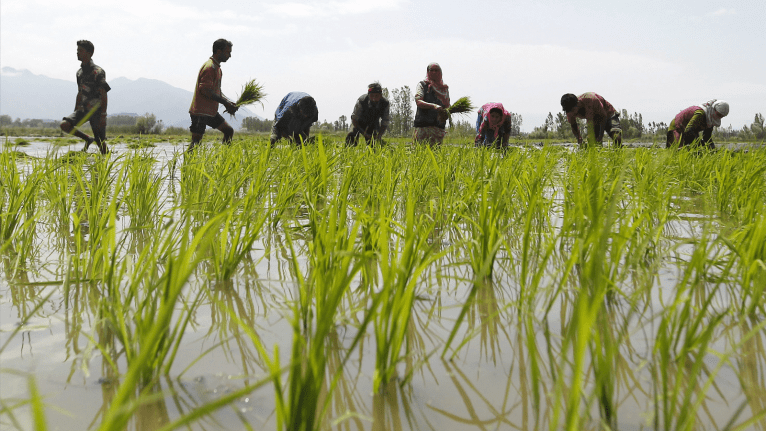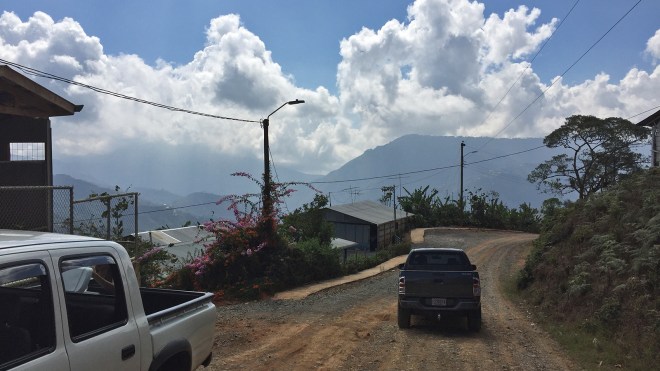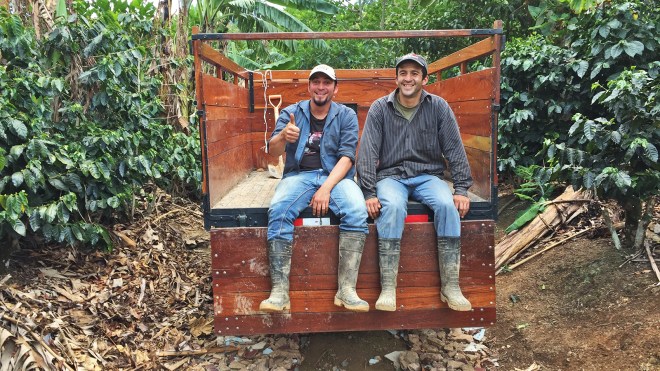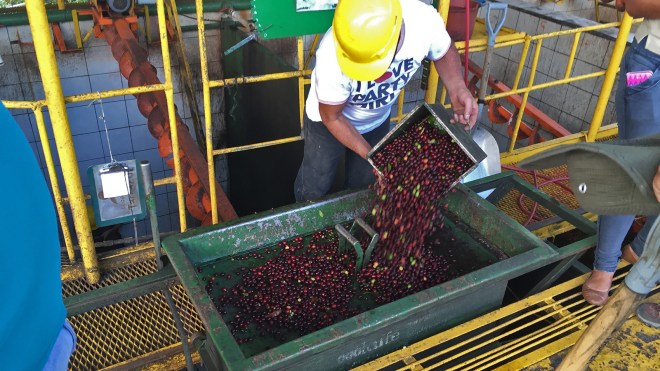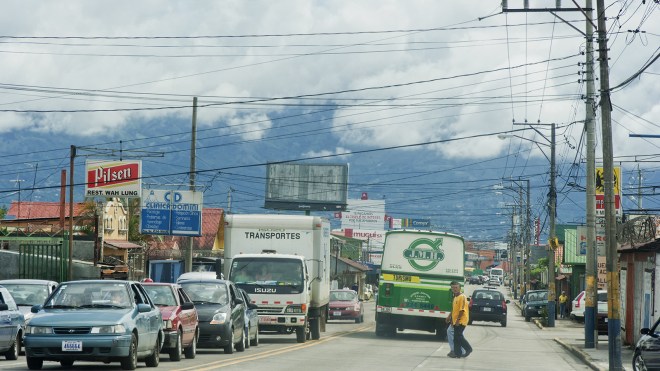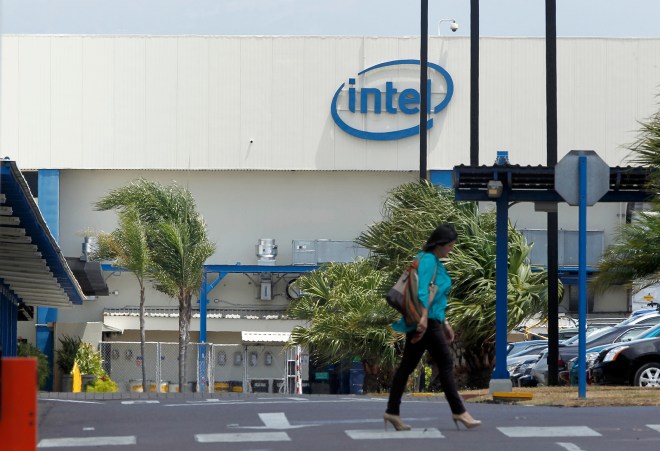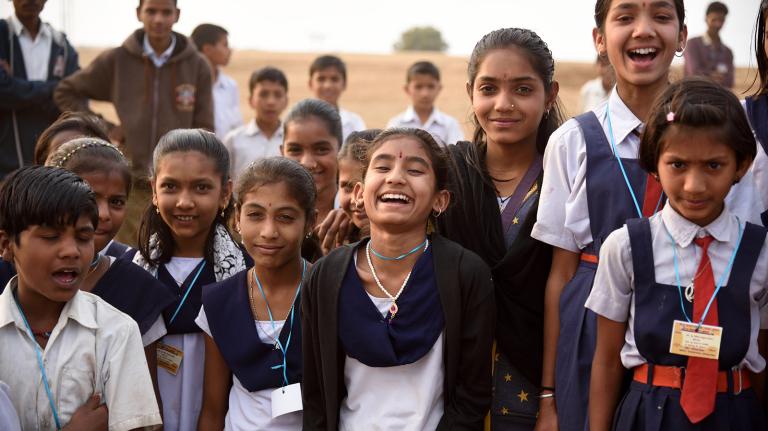First in a series on tackling global poverty while protecting the environment. Read the intro.
For the one in 10 people around the world living on less than $2 a day, life is an emergency. Every day, poverty kills an estimated 15,000 children under the age of 5.
The world’s ambulance is growth. To save those kids, countries need higher incomes, more medical clinics, modern water pipes, and sewage treatment plants.
Switch on the sirens and go screaming down the superhighway of economic growth, however, and the world will spew out enough greenhouse gas emissions to put millions of lives at risk from pollution and climate change. There’s no way poor countries are going to stop and wait until they figure out a zero-carbon route out of poverty — and they shouldn’t.
But what if they could slow down just a little bit, and cut way down on emissions? That would look a lot like Costa Rica.
A few months ago, I got a chance to see for myself. On a clear sunny day, I found myself jolting up a country road in Costa Rica. It definitely wasn’t the aforementioned superhighway — it was a bumpy pass that went straight up a mountain.
I was traveling in the coffee-growing highlands on a trip organized and paid for by the Rainforest Alliance — it certifies sustainable foods (you’ve probably seen its frog stamp of approval) and had flown out a batch of journalists to show us how it’s done. As we bumped up improbable roads, I found myself looking out over the steepest fields I had ever seen. Coffee trees clung to the mountainsides, up one vertiginous slope and down another.
As we crested a ridge and looked ahead to the next, I thought about how difficult it would be for families who owned these farms to get their kids to schools and doctors’ appointments, or even to get electricity out to homes. But at that moment, I spotted a pole bearing wires. When we stopped in the next tiny hamlet, I poked my head in a church. It had electric lights. We were still on the grid.
Costa Rica is well into the transformation from a poor subsistence farming economy to an affluent modern economy. There’s cellphone service just about everywhere. The literacy rate is 97.8 percent. The country has universal health care and vaccination rates higher than the United States. Just 1.7 percent of households lack potable water. Statistically, even the poorest residents are comparatively healthy. The average Costa Rican lives a little longer than the average person in the United States. The median income is around $7,000 a year — not much compared to the median of $56,000 a year in the United States, but enough to stay well fed.
Throughout history, whenever a country escapes poverty, a bunch of things happen at once. Some farmers start growing more food, while others move to cities. Farming goes from being the primary occupation to a pretty unusual job. Eventually, after people have moved to high-tech jobs, like making microchips or writing code, the economy’s footprint shrinks. Forest cover increases. Incomes rise. Birth and death rates drop. Economists call this the “structural transformation,” and it’s important enough that we’ve devoted an entire piece explaining it. The evidence is overwhelming: “Indeed, if history is any guide, no escape from hunger and poverty has been sustainable without a successful structural transformation,” wrote the economic historian, Peter Timmer.
Usually a country in the throes of this transformation also trashes the environment along the way. But not Costa Rica; the country has accomplished all of this without adding much gas to the global greenhouse. Costa Ricans create a tenth of the emissions of people in the United States, and that’s not just because they are poorer. The economy runs cleaner: It takes half as much carbon to produce the same amount of goods and services in Costa Rica as it does in the United States. The country aims to be carbon neutral by 2021. Its electrical grid has been running for months on end on clean energy.
So if we look to Costa Rica as a model for other countries that want to tackle poverty sustainably, what can we learn?
Brewing strong coffee alliances
When I finally got off that terrifying road, I walked into a steep field owned by two brothers, Jonathan and David Vega Cerdas. Rows of chest-high coffee trees ran along the contour lines. Taller trees and banana plants provided dappled shade. The slope dropped away to a gray-green reservoir far below: one of the country’s many hydroelectric dams, I would later learn.
Jonathan is older and cheery — he had recently gotten married and started his own family. David is quiet, with a shy wit — he’s a dirt-bike enthusiast, and when I asked if he was married, he joked that he was married to his motorcycle.
Their farm is small, just 7.5 acres, which is typical of this region in the Tarrazú mountains south of the capital. Jonathan and David’s father had worked in the United States, and returned with enough money to buy the land.
There are a lot of small plots like this one in Costa Rica because the government gave land to citizens starting in the 1800s and continuing through the 1960s. This formed a large population of yeoman farmers. Distributing land was a cheap form of welfare — it gave poor people a way to make a living and control their own destiny.
It also gave them a say in politics. Countries dominated by a few elites employing an underclass of laborers tend to respond to the complaints of the poor with violence. But in Costa Rica, “relatively equal land distribution, access to unclaimed crown lands for poor farmers, and the lack of an easily exploitable indigenous population produced a large class of free farmers unused to subjugation by the colony’s leading families,” write historians Christine Wade, John Booth, and Thomas Walker in Understanding Central America (all following historical references come from this source). Land distribution helped the poor, but hurt the environment: In the 1970s, Costa Rica had one of the highest deforestation rates in the world.
Because it had a relatively democratic government, Costa Rica poured money into education, health, and agriculture, starting before 1900. This allowed small farmers to build up savings and send their children to school. The government investment was spread fairly equitably.
That’s a key difference between Costa Rica and countries that trashed the environment while moving out of poverty. In many countries, as economies grow, a few people capture the wealth while the rest remain desperately poor. And so those countries are stuck longer in the ugly, polluting period of economic immaturity: In the countryside, hungry people knock down forests to survive; in the city, the people laboring the smokestacks are mostly too desperate to advocate for better conditions, explains Princeton economist Angus Deaton in his book The Great Escape: Health, Wealth, and the Origins of Inequality. For example, in England’s industrial revolution, writes Deaton, the Dickensian conditions of the “dark, satanic mills,” weren’t miserable because industrialization was bad, but because the government failed to provide clean water and toilets for laborers. Peasants moving to factory jobs in the cities got higher incomes, but they also got cholera.
But in Costa Rica, people moving to cities already had some money, skills, and education. Those who stayed on the farms also got more money and education, and they organized to endow themselves with greater economic and political power.
The Vega brothers, for instance, are part of a cooperative of some 400 farmers, called CoopeTarrazú, which processes and markets its own beans. Farmers acting on their own only get a tiny share of the final market price for their crops, but the members of CoopeTarrazú are able to get more money for their work because they collectively own most of the value chain for their coffee. They grow it, collect it, clean and dry it, and sell the beans to companies like Caribou Coffee.
Their coffee collective is also a potent political force. “The government doesn’t do anything affecting coffee without consulting us,” said Félix Monge, CoopeTarrazú’s field and business manager. It’s institutions like this that push politicians to take care of the people they represent.
Government or nonprofit investment in agriculture doesn’t go very far if their agents have to talk to small farmers one at a time. That’s a major challenge for farmer education efforts around the world, Melinda Smale, a professor of international development at Michigan State, told me. But when farmers work together, it becomes much easier to help them improve their techniques.
The Rainforest Alliance had taken me to see the Vega brothers because the group had worked with CoopeTarrazú agronomists to zero in on better forms of management. They planted nitrogen-fixing trees, cut back on their pesticide use, and dug soil amendments into their fields. Their father thought they were crazy, and neighbors who saw the diversity of trees beginning to rise over the farm jokingly asked if they were growing coffee or a forest.
But these methods allowed the brothers to double their yields while cutting their fertilizer use in half.
When you make just enough to get by, it’s hard to take a risk on new, supposedly more sustainable techniques. The development of institutions in Costa Rica — like farmers’ cooperatives and a stable government — has allowed more rapid diffusion of new ideas and technologies to lots of small farmers. More than half of the farmer-members of CoopeTarrazú have earned the Rainforest Alliance certification for sustainability.
The elephants in the green room
There are a lot of things about Costa Rica worth copying, but there are also ways in which it’s a horrible role model. The country has a history of yeoman farmers in part because the colonial Spanish almost completely killed off the indigenous people.
In other parts of the Americas, colonial powers enslaved or exploited the people they colonized. But in Costa Rica, the colonists had to do the farming themselves. This put the country on a more democratic track than its neighbors, but for the worst possible reasons.
Costa Rica also got lucky during the Cold War. While foreign meddling wreaked havoc in Nicaragua, El Salvador, and Honduras, U.S. interference in Costa Rica came mostly in the form of money. The United States paid Costa Rica over a billion dollars in the 1980s to allow the Contras (Nicaraguan counterrevolutionaries) to set up bases within its border.
This money allowed the country to keep its safety net relatively intact through a severe recession. Costa Rica got aid that stabilized the democratic government, while its neighbors got coups. That’s not a model other countries can follow.
But there’s an obvious lesson for wealthy countries seeking to help: Using poor countries for proxy wars increases poverty and environmental depredation; providing aid money can do just the opposite.
There’s nothing green about traffic
On my visit to Costa Rica, we spent hours inching across the capital city San José, guided through narrow surface streets using the app Waze. It’s popular in Costa Rica because the obvious routes are frequently locked with traffic. As the country moved from a primarily agricultural economy to a manufacturing and service economy, people left their farms for San José. They took jobs making microchips and medical devices for international corporations that came looking for an educated workforce.
But the country failed to provide mass transit options to get these commuters to work. So people bought cars. Today, transportation is a growing source of pollution.
That’s not the end of the country’s infrastructure woes: The electrical lines that impressed me so much are aging, and many towns need new sewage treatment plants. Costa Rica’s deteriorating infrastructure is a turnoff for international companies looking for a place to set up shop.
Costa Rica’s green image is clearly a selling point for companies: All you have to do is move there and: Boom! You’re running on nearly 100 percent renewable electricity. That green reputation also draws thousands of tourists. But tourism and foreign corporations aren’t enough for a vibrant economy. For real stability and green prosperity, Costa Rica will need more homegrown companies.
In theory, after you use tax breaks to lure in a company like Intel, as Costa Rica did in 1997, new companies start to spring up around it. Perhaps someone opens shop next door to provide parts. Perhaps locals — who saw a need for something new while working at Intel — found startups. In other words, you get businesses that spawn businesses, jobs that spawn more jobs.
Some of that has happened, but not as much as many had hoped. And there are major problems with courting foreign corporations with tax breaks. If corporations aren’t paying taxes, it means countries have less money for infrastructure and education. It’s also risky: Jobs that come quickly can leave quickly. In 2014, Intel closed its largest operation in Costa Rica.
Takeaways
Costa Rica has a long way to go, but it’s still a worthy role model for pulling populations out of poverty. If Namibia or Haiti could look like Costa Rica in terms of prosperity and sustainability, we’d be cheering.
When people talk about policies for developing countries, the debate over free trade tends to dominate the conversation, but setting that aside for now, there are bigger questions with clearer answers. How do you go from growing beans and corn and chopping down your forests to manufacturing computer chips and leading eco tours? What are the keys to this green structural transformation?
- Investment in agriculture: By giving away small plots of land, Costa Rica ensured that its economic progress would be widely spread, rather than simply benefiting elites.
- A strong safety net: The country responded to uprisings with social programs — education, healthcare, welfare assistance — instead of repression.
- Foster the development of institutions: As farmers grow more, they form food chains that link up with cities and other countries. That yields institutions with political and economic power, like CoopeTarrazú.
- Be green but not militant: Giving away land to the poor wasn’t green in the short run, but it worked out in the long run. As Jonathan Vega told me: “When my grandparents got here, this was all forest, and they saw it as an obstacle to get out of the way.” Now the brothers are adopting better methods, but they are still primarily in the coffee business, not the restoration business. Growth requires change — we shouldn’t try to impose the “leave no trace” ethic on countries in poverty.
The history of Central America I cited above notes that Costa Rica has repeatedly done better than its neighbors. Why? All the reasons listed above boil down to governance. The democracy managed to keep investing in the people, rather than allowing a few powerful people to direct policies to their own end. At least, if you look at the big picture.
At the end of my trip to Costa Rica, I got a very small-picture reminder that the country still has a way to go: One after another, my group of journalists and Rainforest Alliance workers turned green and went running for the bathroom. We’d probably slurped up some bug in the water. I waddled onto the airplane back to the United States clutching a box of anti-diarrheal pills. It’s easy enough to find vomit-inducing examples of bad governance — or bad water systems — in Costa Rica. But the national statistics, and my overwhelmingly positive impressions of the country, suggest it’s doing something right: healing the environment by helping the people.
If more countries follow something like Costa Rica’s path, there’s real hope that people around the world could make it onto the ambulance out of immiserating poverty while also improving the world for future generations. In the next installment I’ll take a step back and lay out the evidence for hope in 10 charts — it’s entirely possible to for the people in the greatest peril to become prosperous while simultaneously shrinking their footprint on the land.
